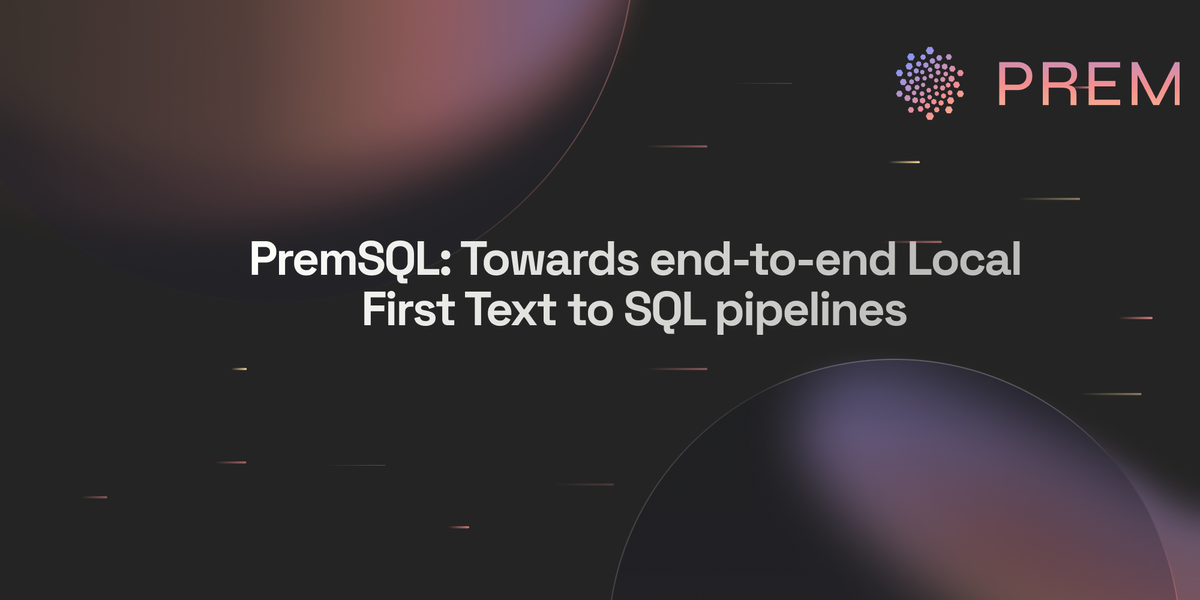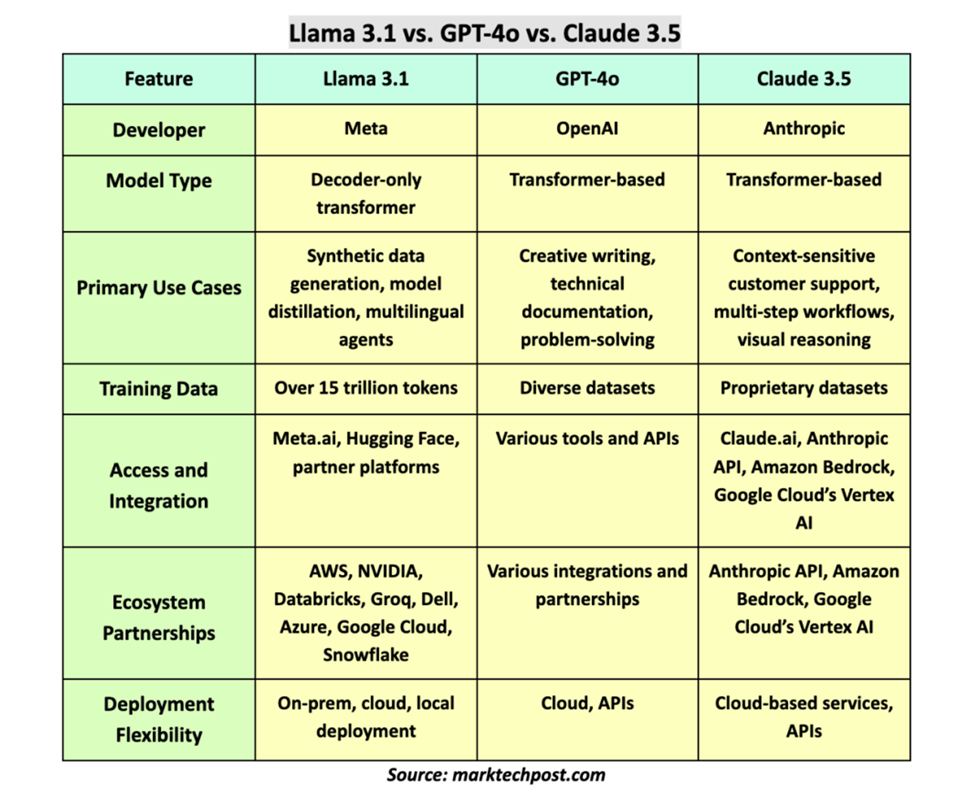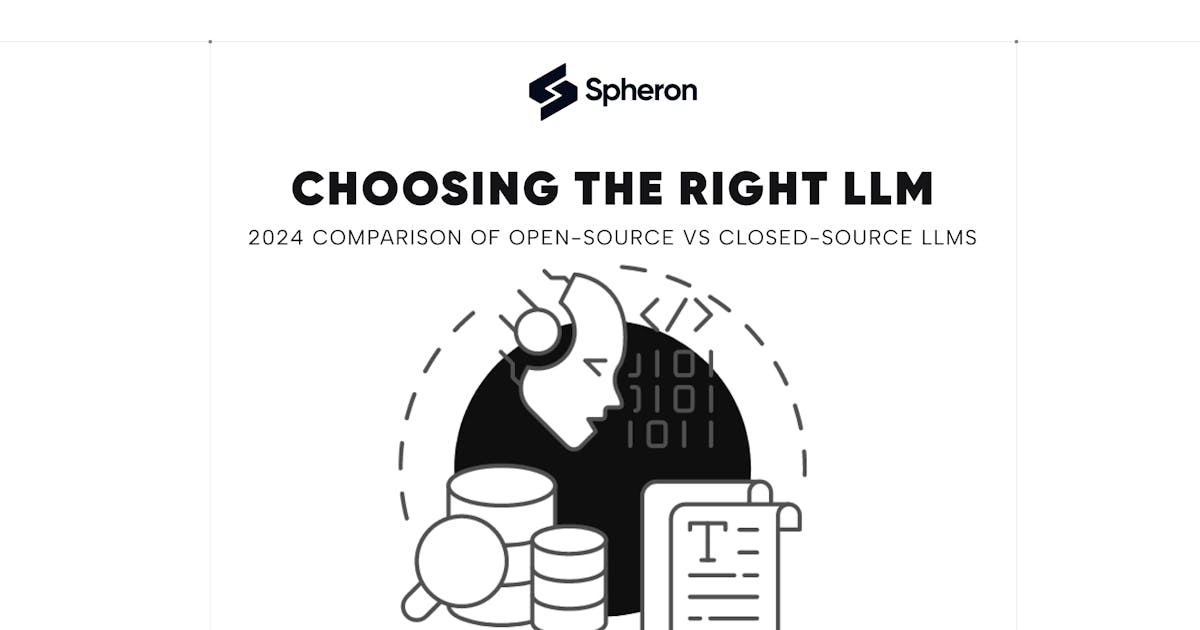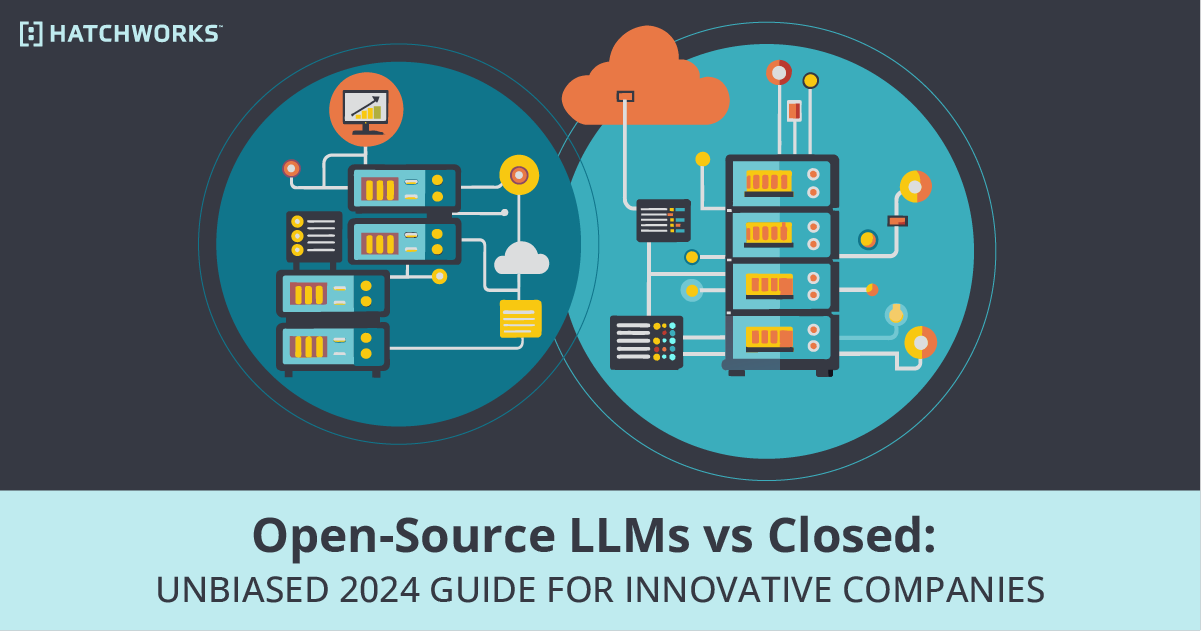Are Open-Source Models Good Now?
Open-source LLMs like Llama 3.1 and Prem-1B-SQL offer affordability, flexibility, and customization, rivaling closed-source models like GPT-4o in performance. With enhanced transparency and control, they are ideal for businesses seeking scalable and innovative AI solutions tailored to their needs

Open-Source LLMs: How Llama 3 and Cohere Are Changing the AI Landscape
The field of large language models (LLMs) is undergoing rapid evolution, with open-source models like Llama 3, Cohere, and others making significant strides. Historically dominated by proprietary models, the landscape is now shifting as open-source models close the performance gap with their closed-source counterparts. Llama 3.1, for instance, boasts a 405-billion parameter architecture that rivals industry leaders such as GPT-4 and Claude 3.5 in benchmarks.
This shift isn't merely technical—it represents a philosophical divide in AI development. While closed-source models prioritize controlled ecosystems and monetization, open-source models foster transparency, collaboration, and customization. The implications are profound: businesses can now choose between flexibility, innovation and security offered by open-source models or the polished, enterprise-grade solutions typical of closed-source systems.
In this article, we'll explore the rise of open-source LLMs, comparing them to closed-source alternatives. We’ll delve into benchmarks, use cases, and costs, demonstrating why open-source models are now a viable—and often superior—choice for businesses and developers alike.
2.The Evolution of Open-Source LLMs
Open-source large language models (LLMs) have come a long way, evolving from basic frameworks to cutting-edge architectures that rival closed-source systems. This section explores the significant milestones and technical advancements that have shaped open-source LLMs into a formidable option for businesses and developers.

Historical Progression
The journey began with rudimentary transformer architectures like GPT-2 and evolved to models like Llama 3.1, which feature expanded context lengths (128K tokens) with additional multi-modal and multilingual capabilities. These developments have democratized access to high-performance AI, enabling smaller organizations to utilize LLMs without heavy reliance on closed ecosystems.

The above figure shows the rise and the evolution of Open Source Models. Recently we are also seeing a massive surge of Small Open Source Language Models which are heavily customizable and can be aligned to work perfectly for user specific tasks.
Technical Advancements
Llama 3.1 exemplifies the open-source community's progress, boasting a 405-billion parameter architecture designed for scalability and stability. This level of sophistication was previously exclusive to proprietary systems, underscoring the narrowing performance gap between open and closed-source models.
Partnerships Driving Innovation
Key collaborations with AWS, NVIDIA, and other tech leaders have bolstered the accessibility of open-source models. These partnerships facilitate seamless integration, additional fine-tuning, and deployment across various platforms, further enhancing the utility of open-source LLMs.

3. Open-Source vs. Closed-Source Models: A Comparative Analysis
The debate between open-source and closed-source large language models (LLMs) has grown as businesses weigh flexibility, cost, and control against the polished, out-of-the-box performance of proprietary systems. Both approaches cater to different organizational needs, but understanding their intricacies is crucial for informed decision-making.
Customization and Deployment
Open-source models offer unmatched customization, allowing organizations to adapt AI systems to niche requirements. For example:
- Prem-1B-SQL, a fully local, performant small language model (SLM) for Text to SQL tasks, demonstrates the potential for secure, efficient deployment in environments with strict data privacy regulations. Its flexibility lies in being fine-tuned for specific database queries, reducing dependency on external APIs while maintaining robust performance
Below is a snippet demonstrating how Prem-1B-SQL can be deployed to handle SQL generation tasks locally:
from premsql.generators import Text2SQLGeneratorHF
from premsql.executors import SQLiteExecutor
executor = SQLiteExecutor()
generator = Text2SQLGeneratorHF(
model_or_name_or_path="premai-io/prem-1B-SQL",
experiment_name="test_generators",
device="cuda:0",
type="test"
)
question = "show me the yearly sales from 2019 to 2020"
db_path = "some/db/path.sqlite"
response = generator.generate(
data_blob={
"prompt": question,
"db_path": db_path,
},
temperature=0.1,
max_new_tokens=256,
executor=executor,
)
print(response)Source: PREM-1B-SQL
In order to use this code, make sure you have installed PremSQL with PyTorch and HuggingFace transformers.
pip install -U premsql torch transformers
- Closed-source models like GPT-4 provide comprehensive, ready-to-deploy solutions but lack the flexibility to adapt to highly specialized or experimental use cases. Additionally for privacy focussed tasks like Text to SQL, using closed source models might lead to some serious data breaches.
Integration and Ecosystem Support

Closed-source models typically integrate seamlessly into existing ecosystems due to vendor support and pre-built APIs. However, this convenience can limit innovation. However, opensource alternatives, such as Llama 3.1, empower developers to fine-tune and integrate models into unique workflows, but comes with a steeper learning curve. Organizations leveraging open-source models can avoid vendor lock-in, enabling easier scaling and integration with other available tools.
Cost and Maintenance
Cost is often a decisive factor:
- Open-source models typically involve lower upfront costs but require skilled teams for customization and maintenance.
- Conversely, closed-source solutions bundle support and updates into predictable subscription fees, appealing to organizations without extensive technical expertise.

Security and Compliance
For industries dealing with sensitive data, the choice between open and closed-source solutions can hinge on security:
- Open-source models offer transparency and the ability to host data locally, as exemplified by Prem-1B-SQL. This ensures compliance with stringent data privacy regulations.
- Closed-source models, while secure, often involve reliance on vendor infrastructure, which can pose risks for certain compliance-sensitive applications.
4.Real-World Use Cases of Open-Source Models
Open-source large language models (LLMs) have shown their potential across various domains, from business intelligence to creative applications. Their flexibility and accessibility have enabled organizations to address unique challenges with customized solutions.
Business Applications: Prem-1B-SQL
One remarkable example is Prem-1B-SQL, a specialized small language model for translating text into SQL queries. This fully local, performant model enables businesses to maintain data privacy while leveraging AI for database interactions. Its integration with tools like SQLite highlights the seamless customization capabilities of open-source models.
Creative Industries: Generative AI Tools
In creative sectors, open-source text to video models like Mochi-1 by GenmoAI empower designers and filmmakers to generate sharp, motion-rich visuals. These advancements underscore the utility of open-source models in non-traditional AI applications, paving the way for innovations in multimedia.
Enterprise Use Cases: Llama 3.1
Llama 3.1 has been widely adopted in multilingual processing, synthetic data generation, and natural language understanding. With its expanded context window of 128K tokens, it supports complex workflows like document analysis and interactive AI assistants.
5.Performance Benchmarks
Performance benchmarks are a critical factor in evaluating large language models (LLMs), as they highlight differences in capabilities, speed, and cost across various use cases. In this section, we compare key open-source and closed-source LLMs based on standardized metrics and real-world applications.
Reasoning and Task-Specific Performance
Benchmark tests reveal nuanced differences among models. For instance:
- GPT-4o leads in mathematical reasoning with an accuracy of 86%, followed by Gemini 1.5 at 71%, and Llama 3.1 at 64%.
- For customer ticket classification, GPT-4o demonstrates the highest precision (89%) but is closely followed by Claude 3.5 Haiku with a balanced F1 score of 75%.
- Although GPT-4o does very well on BirdBench (a benchmark for evaluating Text to SQL tasks), Qwen 2.5 coder and Prem-1B SQL are on par with the GPT-4o's performance.
Throughput and Latency
Open-source models often outperform closed-source alternatives in throughput:
- Llama 3.1 achieves up to 250 tokens per second, significantly faster than GPT-4o mini (103 tokens per second).
- In terms of latency, GPT-4o mini matches competitive proprietary standards with a runtime of 0.56 seconds per query.
Cost Efficiency
Cost analysis underscores the affordability of open-source models:
- Llama 3.1 costs $0.60 per million input tokens, far cheaper than GPT-4o’s $0.15 per input token but with reduced output costs at $0.6 million.
- Claude 3.5 offers competitive pricing but with limited flexibility compared to open-source counterparts.
Why Enterprises Care About Open-Source
This chart highlights the primary reasons enterprises choose open-source models, emphasizing:
- Control: Ensuring data privacy and security.
- Customizability: Adapting models to specific workflows and industries.
- Cost: Reducing operational expenses compared to closed-source solutions.
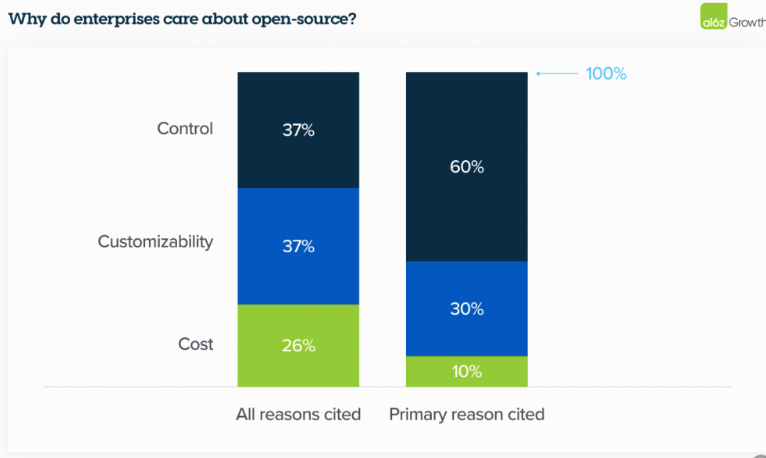
The image reinforces how these motivations align with the performance advantages discussed above.
6.Cost Analysis
Cost remains one of the most significant considerations for businesses choosing between open-source and closed-source large language models (LLMs). Open-source models have emerged as a cost-effective alternative, but understanding the full spectrum of cost implications is essential.
Initial and Operational Costs
Open-source models like Llama 3.1 present significantly lower initial costs compared to proprietary models. For instance:
- Llama 3.1 costs approximately $0.60 per million input tokens, while GPT-4o mini costs $0.15 per million input tokens.
- Closed-source models, however, often include licensing fees and ongoing costs for vendor support and updates, which can simplify maintenance for less technical teams.
Total Cost of Ownership
Although open-source models are more affordable upfront, they often require additional investment in:
- Infrastructure: Businesses may need powerful hardware for local deployment.
- Technical Expertise: Skilled personnel are required for fine-tuning, maintenance, and troubleshooting.
Closed-source models offset these needs with vendor-provided support, making them attractive for enterprises without in-house expertise but at a higher total cost of ownership.
Scalability and Long-Term Costs
Scaling open-source solutions can be economical for organizations with technical teams in place. However, proprietary solutions like GPT-4o mini and Claude 3.5 Haiku offer predictable costs and comprehensive scalability options, suitable for enterprises requiring rapid deployment.
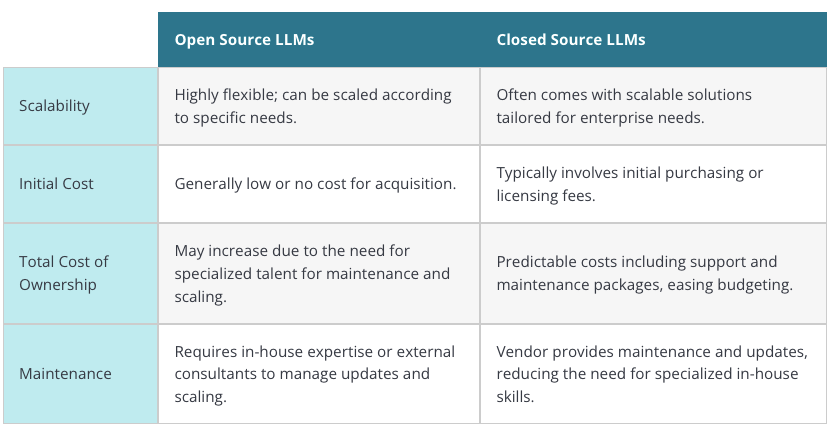
This table provides a clear comparison of the operational and financial considerations businesses must account for when choosing between open-source and closed-source models.
7.Security and Ethical Considerations
The adoption of large language models (LLMs) often raises concerns about data security and ethical practices. Open-source models, such as Llama 3.1, offer unique advantages in transparency and control, while closed-source models provide robust, vendor-backed security measures.
Enhanced Security with Open-Source Models
Open-source models allow businesses to host solutions on their private infrastructure, minimizing risks associated with third-party data sharing. For example:
- Prem-1B-SQL, a fully local model for SQL tasks, exemplifies the enhanced control organizations can achieve when deploying models on private hardware.
- Transparency in open-source software facilitates thorough audits, ensuring compliance with security standards and reducing vulnerabilities.
Ethical AI Practices and Transparency
Open-source models promote ethical development by allowing the community to scrutinize and improve the codebase:
- Developers can audit training datasets to identify and mitigate biases, fostering trust in the AI's outputs.
- Community-driven improvements ensure that ethical considerations remain a priority, aligning with global standards for responsible AI.
Challenges with Closed-Source Models
While closed-source models offer robust vendor support, they present challenges in terms of transparency:
- Proprietary systems are often "black boxes," limiting visibility into data handling and decision-making processes.
- Businesses relying on closed-source models must trust vendors to maintain compliance with privacy laws and ethical standards.
8.The Future of Open-Source Models
The rapid evolution of open-source large language models (LLMs) has redefined the AI landscape, challenging the dominance of closed-source systems. Models like Llama 3.1 and Mistral Large 2 showcase the potential of open-source solutions to drive innovation, affordability, and transparency.
Embracing Open-Source for Innovation
The adaptability of open-source models empowers organizations to innovate without the constraints of proprietary ecosystems. With tools like Prem-1B-SQL offering local, secure deployment options, businesses can achieve unparalleled control over their AI implementations.
A Balanced Future
While open-source models excel in customization and cost-efficiency, closed-source models still hold an edge in ease of integration and vendor-backed support. However, the trend toward hybrid adoption—leveraging both open and closed solutions—is likely to dominate as businesses balance flexibility with reliability.
The Road Ahead
The narrowing gap between open-source and closed-source performance metrics indicates a future where open-source models are not just viable alternatives but often preferred choices for enterprises. Continued collaboration within the open-source community will further enhance these models, setting new benchmarks for what AI can achieve.
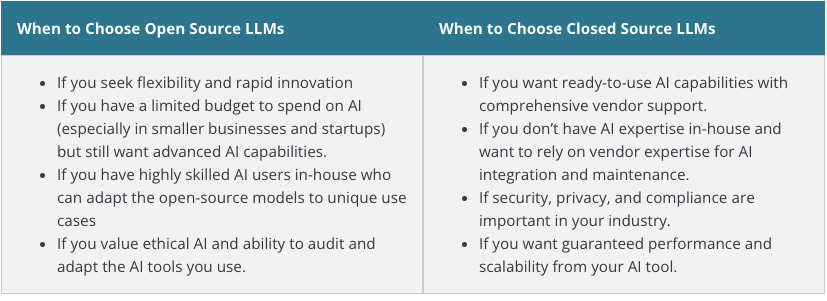
References:

